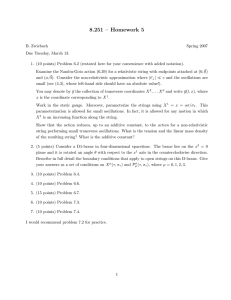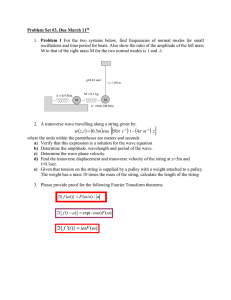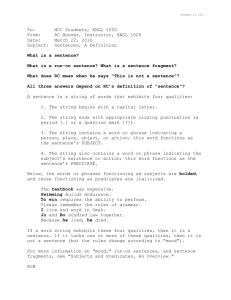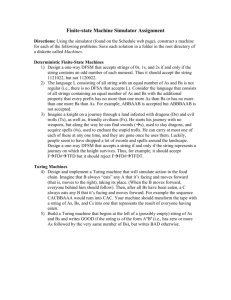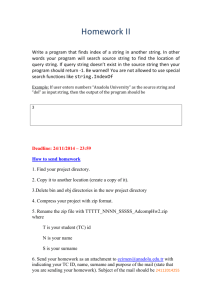Transverse Waves on an Inelastic Vertical String
advertisement
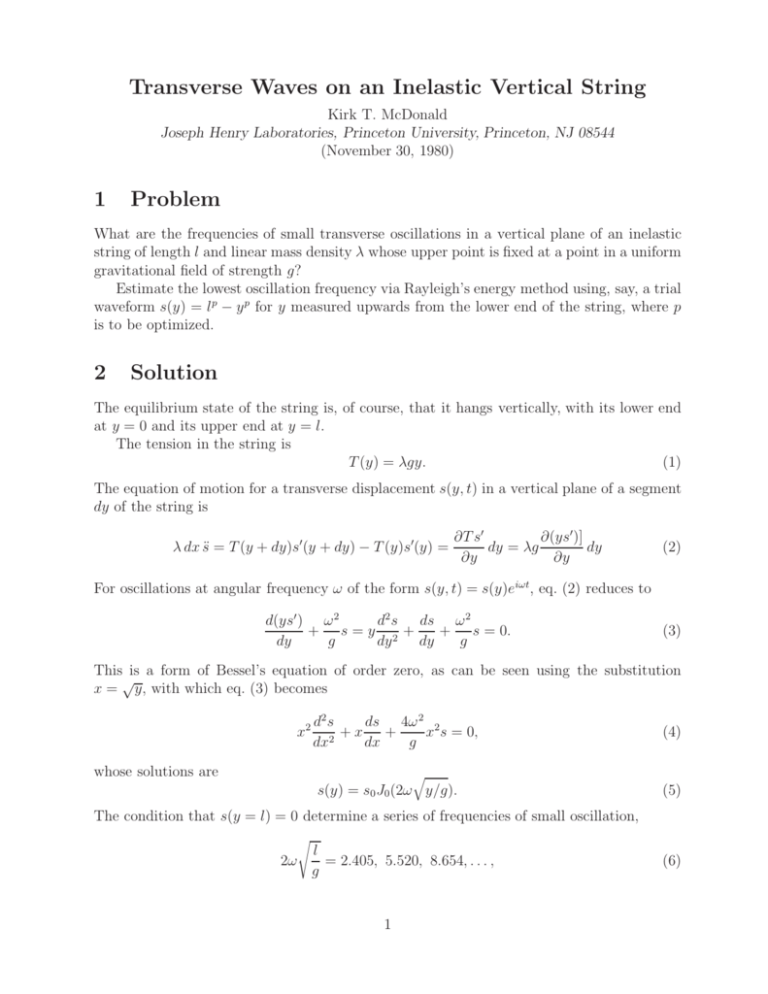
Transverse Waves on an Inelastic Vertical String Kirk T. McDonald Joseph Henry Laboratories, Princeton University, Princeton, NJ 08544 (November 30, 1980) 1 Problem What are the frequencies of small transverse oscillations in a vertical plane of an inelastic string of length l and linear mass density λ whose upper point is fixed at a point in a uniform gravitational field of strength g? Estimate the lowest oscillation frequency via Rayleigh’s energy method using, say, a trial waveform s(y) = lp − y p for y measured upwards from the lower end of the string, where p is to be optimized. 2 Solution The equilibrium state of the string is, of course, that it hangs vertically, with its lower end at y = 0 and its upper end at y = l. The tension in the string is T (y) = λgy. (1) The equation of motion for a transverse displacement s(y, t) in a vertical plane of a segment dy of the string is λ dx s̈ = T (y + dy)s(y + dy) − T (y)s(y) = ∂(ys)] ∂T s dy = λg dy ∂y ∂y (2) For oscillations at angular frequency ω of the form s(y, t) = s(y)eiωt, eq. (2) reduces to d2 s ds ω 2 d(ys ) ω 2 + s=y 2+ + s = 0. dy g dy dy g (3) This is a form of Bessel’s equation of order zero, as can be seen using the substitution √ x = y, with which eq. (3) becomes x2 ds 4ω 2 2 d2 s + x s = 0, + x dx2 dx g whose solutions are (4) s(y) = s0 J0(2ω y/g). (5) The condition that s(y = l) = 0 determine a series of frequencies of small oscillation, 2ω l = 2.405, 5.520, 8.654, . . . , g 1 (6) or g g g , 2.760 , 4.318 ,... (7) l l l Rayleigh notes that for a springlike system, KE = PE (virial theorem), so that a trial waveform with parameter p can be used to estimate the frequency ω(p) using this constraint. Then the lowest frequency is obtained by minimizing ω(p) with respect to the parameter p. We consider the form (8) s(y, t) = (lp − y p)eiωt , ω = 1.202 for which the time-average kinetic energy is l 1 λω 2 l p λω 2 2p+1 2 l + = (l − y p)2 dy = 1− KE = 4 0 4 p + 1 2p + 1 0 2 2 λω 2p+1 2p = l , 4 (p + 1)(2p + 1) λṡ2 dy 2 (9) and the time-average potential energy (= work done in stretching the string) is PE = 0 l T( 1 + s 2 − 1) dy ≈ 0 l λg T s 2 dy = 2 4 l 0 y(−py p−1)2 dy = λg 2p p l . (10) 4 2 Equating the kinetic and potential energies, we have that g (p + 1)(2p + 1) . l 4p √ The minimum frequency occurs for p = 1/ 2, which implies that its value is ω 2(p) = ω≈ g l (11) 1.707 · 2.414 g = 1.207 , 2.828 l (12) which compares well with the “exact” value of 1.202 g/l. For additional discussion, see A.B. Western, Demonstration for observing J0 (x) on a resonant rotating vertical chain, Am. J. Phys. 48, 54 (1980), http://physics.princeton.edu/~mcdonald/examples/mechanics/western_ajp_48_54_80.pdf 2
